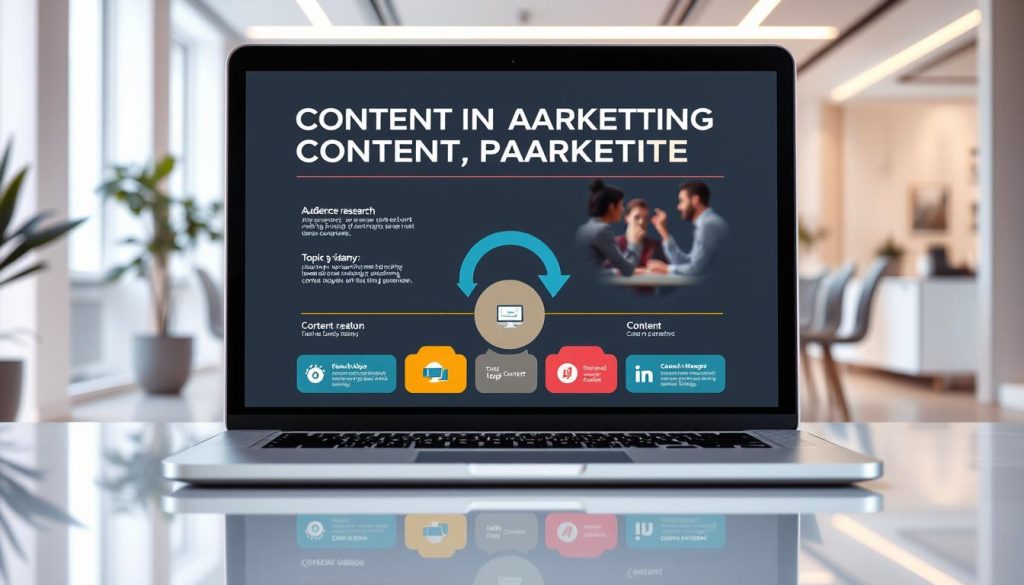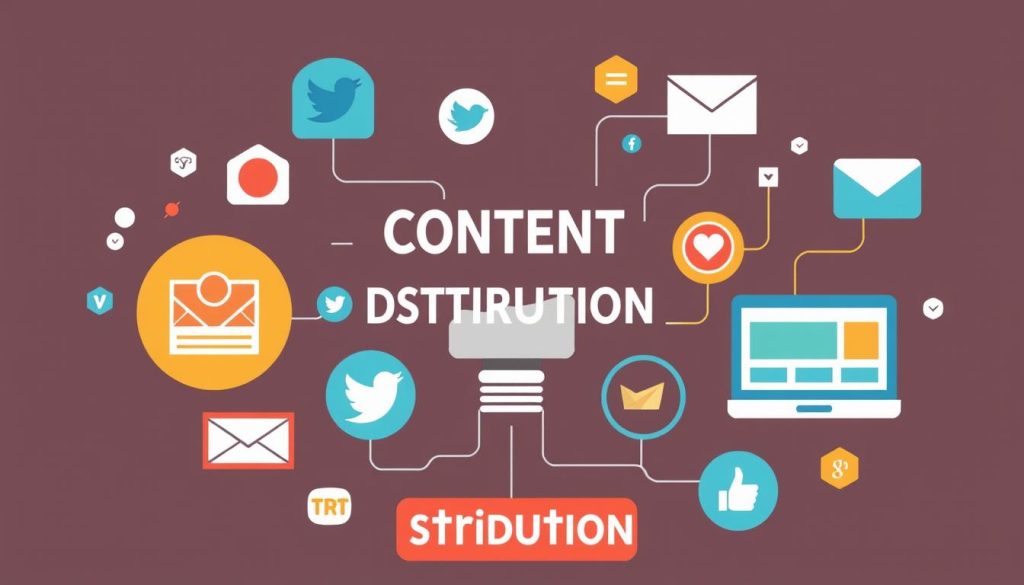In today’s competitive business landscape, lead generation is crucial for growth. We help you understand the strategic role of content marketing in capturing high-quality leads.
By creating valuable content, businesses can attract and engage their target audience, driving them through the sales funnel. This comprehensive guide breaks down the connection between content creation and effective lead generation, providing actionable techniques to transform your efforts into a lead-generating machine.
Key Takeaways
- Understand the strategic approach of using content marketing to generate high-quality leads.
- Discover how to transform your content efforts into a lead-generating machine.
- Learn proven frameworks to capture and convert more qualified leads through strategic content deployment.
- Gain a clear roadmap for implementing a content strategy that consistently delivers qualified leads.
- Explore why content marketing has become the cornerstone of modern lead generation strategies.
Understanding Content Marketing and Lead Generation
Content marketing and lead generation are intertwined concepts that form the backbone of a successful digital marketing strategy. To leverage these concepts effectively, businesses must understand their definitions, applications, and interconnections.
What is Content Marketing?
Content marketing is a strategic approach focused on creating and distributing valuable, relevant, and consistent content to attract and retain a clearly defined audience. It’s about providing value before extracting it, differing significantly from traditional marketing methods. By doing so, businesses can establish trust and authority with their target audience.
Types of Leads in the B2B Space
In the B2B space, leads are categorized into four types based on their level of interest and qualification: Marketing Qualified Leads (MQLs), Sales Qualified Leads (SQLs), Product Qualified Leads (PQLs), and Service Qualified Leads. Understanding these categories is crucial for tailoring marketing strategies and improving sales processes.
| Lead Type | Description | Qualification Criteria |
|---|---|---|
| MQL | Shows interest in marketing materials | Engages with content, downloads resources |
| SQL | Ready for sales team engagement | Meets specific criteria set by sales team |
| PQL | Has experienced the product’s value | Uses product or trial, shows potential for conversion |
| Service Qualified Lead | Requires specific service or support | Needs assessment for service or support |
The Connection Between Content and Leads
The connection between content consumption and lead generation is fundamental. Content serves as the bridge between anonymous visitors and identified prospects. By strategically deploying content across multiple touchpoints throughout the buyer’s journey, businesses can effectively guide potential customers toward conversion. 
Content is the currency of the digital marketing era, facilitating the exchange of value between businesses and potential customers. By understanding and leveraging this connection, businesses can enhance their lead generation efforts and drive sustainable growth.
Why Content Marketing is Powerful for Lead Generation
The effectiveness of content marketing in generating leads is multifaceted, rooted in its cost-efficiency and ability to build trust with the target audience. This dual advantage sets content marketing apart from traditional marketing methods.

Cost-Effectiveness Compared to Traditional Marketing
Content marketing costs 62% less than outbound marketing and creates three times more leads. This significant difference in cost-effectiveness is a compelling reason for businesses to shift their focus towards content marketing for lead generation.
- Content marketing provides a higher return on investment (ROI) compared to traditional advertising channels.
- The cost savings can be reinvested in creating more content, further enhancing the lead generation potential.
Building Trust and Authority with Your Audience
Consistently delivering valuable content establishes your brand as a trusted authority in your industry. This trust is foundational for building long-term customer relationships that go beyond transactional interactions.
- Trust-building through content marketing fosters loyalty and encourages repeat business.
- A trusted brand is more likely to be considered during the buying process, increasing the chances of conversion.
Long-Term Benefits of Content Marketing
The long-term benefits of content marketing include reduced customer acquisition costs, higher customer lifetime value, and increased brand equity. Content assets continue to generate leads long after their creation, providing a sustainable lead generation ecosystem.
- Content marketing creates a compounding effect where the value of your content grows over time.
- The long-term nature of content marketing means that businesses can enjoy sustained lead generation without the ongoing costs associated with paid advertising.
The Content Marketing Funnel for Lead Generation
The content marketing funnel is a systematic approach to guiding prospects from awareness to decision. It’s a strategic framework that aligns content with the buyer’s journey, ensuring that potential customers receive the right information at the right time.
Top of the Funnel (TOFU): Awareness Stage
At the top of the funnel, the focus is on attracting a wide audience through educational content such as blog posts, guides, and social media posts. The goal here is to build awareness and establish trust without directly promoting products or services. By creating valuable and relevant content, we can cast a wide net and draw in potential customers who are just beginning their buyer’s journey.

Middle of the Funnel (MOFU): Consideration Stage
As prospects move into the middle of the funnel, they are ready to consider their options. Here, content marketing efforts focus on converting visitors into leads through gated assets like ebooks, webinars, and tools that address specific pain points. By offering valuable resources in exchange for contact information, we can nurture leads and guide them further down the funnel.
Bottom of the Funnel (BOFU): Decision Stage
At the bottom of the funnel, prospects are poised to make a decision. Content at this stage should help overcome any final objections by providing case studies, product comparisons, and demonstrations. By presenting leads with the information they need to make an informed decision, we can increase the likelihood of conversion and ultimately drive lead generation success.
Developing a Lead-Generating Content Strategy
A well-crafted content strategy is the backbone of any successful lead generation campaign. To drive meaningful results, businesses must develop a comprehensive plan that aligns with their overall marketing objectives. In this section, we’ll guide you through the essential steps of creating a content marketing strategy that generates qualified leads.
Setting SMART Goals for Your Content
The first step in your content marketing plan is to set your goals. What are you hoping to achieve? Why are you creating content? You need to ensure your marketing objective is something you can act on. For that, we recommend using a SMART goal. This acronym stands for: Specific, Measurable, Achievable, Relevant, Time-based. By setting SMART goals, you can transform vague objectives like “generate more leads” into actionable targets, such as “increase qualified leads by 25% over the next two quarters.”
Identifying Your Target Audience
Understanding your audience is crucial for creating content that resonates with them. To do this effectively, you’ll need to develop detailed buyer personas that go beyond demographics to understand your audience’s challenges, motivations, and content preferences. This involves researching your ideal customer, including their pain points, behaviors, and preferences, to create content that addresses their needs and fosters engagement.

Conducting Keyword Research
Keyword research is a critical component of any lead generation strategy. It’s not just about identifying high-volume search terms; it’s about finding keywords that indicate commercial intent and purchase readiness. We’ll provide a framework for conducting keyword research that focuses on these high-converting keywords, ensuring your content is seen by those most likely to convert into leads.
By following these steps and documenting your strategy, you can maintain consistency and measure progress, ultimately refining your approach to maximize lead generation results.
How Can Content Marketing Generate Leads Effectively
In today’s competitive digital landscape, content marketing stands out as a crucial strategy for lead generation. With approximately 3.75 billion web pages indexed, the competition for attention is fierce. To succeed, you need to create content that not only ranks organically but also resonates with your audience’s needs.

Creating High-Quality, Valuable Content
To generate leads effectively, your content must be of high quality and provide value to your audience. This means understanding your target audience’s pain points and creating content that addresses these needs. High-quality content is not just about being well-written; it’s about being relevant, informative, and engaging.
- Conduct thorough research to understand your audience’s needs.
- Create content that is both informative and engaging.
- Use a tone that resonates with your target audience.
Addressing Search Intent
Understanding and addressing search intent is crucial for attracting visitors who are genuinely interested in your solutions. There are four types of search intent: informational, navigational, commercial, and transactional. For lead generation, focusing on informational and commercial intents can be particularly effective.
To align your content with search intent:
- Identify the intent behind your target keywords.
- Create content that directly addresses this intent.
- Use language that mirrors how your audience searches for solutions.
Consistency and Content Calendar Planning
Consistency is key to building momentum and creating multiple opportunities for lead capture. A well-planned content calendar helps in maintaining this consistency. It allows you to balance evergreen content with timely, trend-based pieces, maximizing your lead generation potential.
To develop an effective content calendar:
- Plan your content around key themes and topics relevant to your audience.
- Schedule content to maintain a consistent publishing rhythm.
- Monitor and adjust your calendar based on performance data.
By focusing on high-quality content, understanding search intent, and maintaining consistency through a content calendar, you can effectively generate leads through content marketing.
Optimizing Your Content for Lead Conversion
Optimizing your content is the linchpin for effective lead conversion. To capture leads, you need to optimize your content for conversions, whether it’s through video marketing or blog posts. For video marketing, this means focusing on thumbnails or ending with a Call-to-Action (CTA). For blog posts, it involves strategically placing CTAs throughout the content.
The best way to optimize your content is to align your CTAs with the content itself. This ensures a natural flow and increases the likelihood of conversion. Another effective strategy is to offer gated content, such as a spreadsheet or template, that users can access by providing their email address.
Strategic Placement of CTAs
Strategic CTA placement is crucial for maximizing conversions. This involves understanding when, where, and how to position your CTAs for maximum impact. Generic CTAs often fail because they don’t resonate with the context. Instead, create contextually relevant CTAs that feel like a natural next step.
For instance, if you’re discussing a specific marketing strategy, your CTA could offer a more detailed guide on that strategy. This approach not only enhances user experience but also increases the chances of conversion.
| CTA Placement Strategy | Description | Conversion Impact |
|---|---|---|
| At the End of Content | Place CTA at the end of a blog post or video. | High |
| Within Content | Embed CTAs within the content where relevant. | Very High |
| On Landing Pages | Use CTAs on dedicated landing pages. | Extremely High |
Using Gated Content Effectively
Gated content is a powerful tool for lead generation. By offering valuable resources like eBooks, whitepapers, or templates, you can capture user information. The key is to ensure that the gated content provides enough value to justify the exchange of contact information.
To implement gated content effectively, consider what types of resources your target audience would find valuable. This could be a comprehensive guide, a cheat sheet, or a webinar. Ensure that the content is relevant and of high quality.

Landing Page Optimization
Landing page optimization is critical for converting visitors into leads. A well-optimized landing page should be focused, distraction-free, and guide visitors toward conversion. It should maintain the trust established by your content and provide a clear call-to-action.
To optimize your landing pages, ensure that they are relevant to the content that led the visitor there. Use clear and concise language, and minimize distractions. Testing different elements, such as CTAs and layouts, can also help improve conversion rates.
Content Distribution Channels for Maximum Lead Generation

The success of your content marketing efforts hinges on the distribution channels you choose for lead generation. Once you’ve created high-quality content, it’s essential to share it across various platforms to maximize its reach and impact.
SEO and Organic Search
SEO is a critical distribution channel for generating leads. By optimizing your content for search engines, you can increase your visibility in organic search results, driving consistent traffic to your website. This traffic is highly valuable because it consists of individuals actively searching for solutions related to your content.
Email Marketing and Newsletters
Email marketing is another powerful channel for distributing your content and nurturing leads. By building an email list and sending targeted newsletters, you can drive traffic to your website and encourage engagement with your content. To maximize the effectiveness of email marketing, focus on building a list of subscribers who are genuinely interested in your content.
Social Media and Community Building
Social media platforms offer a vast opportunity for content distribution and community building. By sharing your content on platforms like LinkedIn, Twitter, and Facebook, you can reach a broader audience and drive engagement. Moreover, social media enables you to build a community around your content, creating a pipeline of warm leads who are more likely to convert.
To maximize your return on content investment, consider repurposing your content across different channels. For example, you can turn a blog post into a video or create an infographic from a data project. This approach not only expands your reach but also caters to different learning preferences, enhancing the overall effectiveness of your lead generation efforts.
Conclusion: Implementing Your Strategic Content Marketing Plan
As we conclude our exploration of content marketing for lead generation, it’s clear that a well-crafted strategy is crucial for success. To effectively implement your strategic content marketing plan, we recommend starting with a comprehensive framework that aligns with your lead generation objectives.
A practical checklist is essential to ensure all critical elements are in place before launching your content marketing strategy. This includes understanding your target audience, conducting thorough keyword research, and creating high-quality, valuable content that addresses search intent.
It’s also vital to be aware of common pitfalls businesses face when implementing content marketing for lead generation, such as inconsistent content publication and neglecting to optimize for lead conversion. By avoiding these mistakes, you can create realistic timelines for seeing results and scale your content marketing efforts as your lead generation needs grow.
Maintaining momentum is key, even when initial results don’t meet expectations. By regularly analyzing performance data and pivoting your strategy as needed, you can refine your approach and achieve better outcomes. Remember, content marketing for lead generation is a marathon, not a sprint, requiring consistent effort and refinement. With these insights, you’re ready to get started on your content marketing journey.
